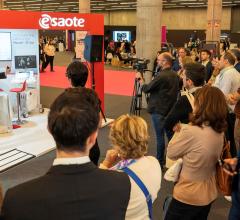December 19, 2011 – The role of cardiovascular ultrasound in the catheterization laboratory has never been appreciated more than it is today. Transcatheter aortic valve implantation (TAVI) allows a multidisciplinary team of interventionalists and echocardiographers to replace a patient's diseased aortic valve without traditional open-heart surgery, enabling a new and potentially life-saving method of treatment for inoperable patients with severe symptomatic aortic stenosis.
“Echocardiography plays an essential role in transcatheter aortic valve replacement. It is required in the pre-procedural evaluation of patients for determining the severity of aortic valve stenosis and characterizing the aortic valve complex. It plays a critical role intra-procedurally throughout every stage of the procedure. Echocardiography is indispensable in the immediate post-implantation stage, when a timely evaluation of complications may prevent adverse outcomes. Finally, follow-up of patients with transcatheter valves requires continued echocardiographic monitoring,” said Rebecca Tung Hahn, M.D., FASE, director of interventional and valvular echocardiography at New York’s Columbia University.
Medical professionals worldwide have new recommendations for the use of echocardiography in identifying patients suitable for these interventions, providing intra-procedural monitoring, and in post-procedure follow-up. The EAE/ASE Recommendations for the Use of Echocardiography in New Transcatheter Interventions for Valvular Heart Disease, a collaborative effort between the American Society of Echocardiography (ASE) and the European Association of Echocardiography (EAE), were published in the September issue of the Journal of the American Society of Echocardiography (JASE).
The U.S. Food and Drug Administration (FDA)’s November approval of the transfemoral delivery of the Sapien transcatheter aortic heart valve was the first U.S. commercial approval of a transcatheter device.
“The FDA approval not only marks a new era for the treatment of aortic stenosis, but also a new era of collaboration and teamwork between echocardiographers and interventionalists,” said Douglas C. Shook, M.D., program director of the Cardiothoracic Anesthesia Fellowship at Brigham and Women’s Hospital at Harvard Medical School. “The echocardiographer is a co-proceduralist during these percutaneous interventions, guiding and assessing the progress and outcome in a real-time, continuous and stepwise manner. It is critical that, during placement of the transcatheter aortic valve, the interventionalist and echocardiographer maintain constant communication regarding anatomic structure and function, as well as progress of the procedure.”
Many, if not all, complications require rapid assessment of the device as well as other cardiac structures, and the echocardiographer’s ability to diagnose rapidly is essential to guiding swift corrective action. “This makes new demands of the echocardiographer, whether he/she is a cardiac anesthesiologist, cardiologist, or sonographer,” Shook said.
“The echocardiographer anticipates as well as responds to the imaging needs of the interventionalist, and so must have a complete understanding of every aspect of the interventional procedure itself,” said Hahn.
Because echocardiographers play such an integral role in this procedure, a session featuring live transmission of a transcatheter aortic valve implantation will take place in conjunction with ASE's 23rd Annual Scientific Sessions in National Harbor, Md. The transmission from the Washington Hospital Medical Center in Washington, D.C., on July 3, 2012, will feature interventional cardiologists and echo faculty.
As the largest global organization for cardiovascular ultrasound imaging, the American Society of Echocardiography (ASE) is the leader and advocate, setting practice standards and guidelines. Comprised of over 15,000 physicians, sonographers, nurses and scientists, ASE is a strong voice providing guidance, expertise and education to its members with a commitment to improving the practice of ultrasound and imaging of the heart and cardiovascular system for better patient outcomes.
Full text of ASE’s guidelines is available at www.asecho.org/guidelines.
For more information about ASE: www.asecho.org


 August 27, 2024
August 27, 2024 








